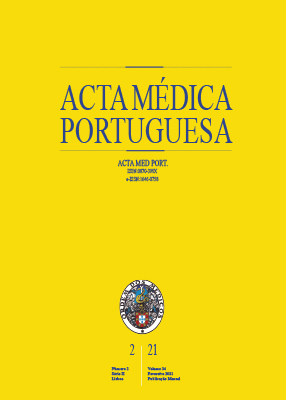Cutaneous Manifestations Associated with COVID-19: A Narrative Review
DOI:
https://doi.org/10.20344/amp.14574Keywords:
Coronavirus Infections, COVID-19, SARS-CoV-2, Skin ManifestationsAbstract
Introduction: COVID-19 is an infectious disease caused by the new coronavirus, SARS-CoV-2, that has spread rapidly throughout the world. This has resulted in an urgent need to obtain information regarding its pathogenesis, diagnosis and clinical manifestations. More specifically, skin manifestations, seldom reported initially, have been increasingly described.
Material and Methods: We performed a literature search in the PubMed database, regarding cutaneous manifestations associated with COVID-19. This article describes the clinical and histological findings of the main skin lesions observed in the context of SARS-CoV-2 infection.
Discussion: Cutaneous manifestations associated with COVID-19 have been described in multiple retrospective and prospective studies, case series and case reports. The reported incidence reached 20.4%. Although there was substantial heterogeneity in terms of clinical patterns, the main ones include: erythematous/maculopapular, urticarial, papulovesicular, and purpuric/petechial eruptions, chilblain-like lesions and livedoid/acro-ischemic lesions. In the vast majority, the underlying pathophysiologic mechanisms are not fully understood, although histopathological findings and biomolecular studies can add relevant data.
Conclusion: The recognition of cutaneous manifestations associated with COVID-19 is of utmost importance. They may help establishing an early diagnosis, namely in oligosymptomatic patients or when confirmatory tests are impossible to perform. Moreover, chilblain-like lesions and acro-ischemia, also seem to play an important role in terms of prognosis.
Downloads
Downloads
Published
How to Cite
Issue
Section
License
All the articles published in the AMP are open access and comply with the requirements of funding agencies or academic institutions. The AMP is governed by the terms of the Creative Commons ‘Attribution – Non-Commercial Use - (CC-BY-NC)’ license, regarding the use by third parties.
It is the author’s responsibility to obtain approval for the reproduction of figures, tables, etc. from other publications.
Upon acceptance of an article for publication, the authors will be asked to complete the ICMJE “Copyright Liability and Copyright Sharing Statement “(http://www.actamedicaportuguesa.com/info/AMP-NormasPublicacao.pdf) and the “Declaration of Potential Conflicts of Interest” (http:// www.icmje.org/conflicts-of-interest). An e-mail will be sent to the corresponding author to acknowledge receipt of the manuscript.
After publication, the authors are authorised to make their articles available in repositories of their institutions of origin, as long as they always mention where they were published and according to the Creative Commons license.









